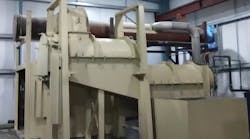Pollution-control continues to be a process and production-cost consideration for iron and steel foundries around the world, due to the preponderance of coke as a fuel for cupola melting. Among the different forms of cupolas available to foundries, the “cokeless” cupola reduces emissions of carbon dioxide (CO2) by 75-80% compared with coke-fired cupolas, and produces the least volume of furnace dust, at 100-120 kg of CO2 and 0.8 kg of dust per metric ton of melt.
However, the cokeless cupola emits more CO gas than a hot blast cupola, at 10 kg or less per metric ton of melt. Because it uses a water-cooled grate to support the charge, the cokeless cupola melts at eutectic temperature. Then, the melt is transferred to a second electrically heated channel furnace to raise the melt back to temperature and proceed with alloying.
Thus, the cokeless cupola melting process requires two furnaces, one gas-fired and one electrically powered, in series, and often this fact discourages small investors who opt instead for a surplus electric furnace. Electric melting reassigns the carbon and particulate emissions back to the electric power plant, and when fossil fuel is used to produce electricity the overall impact on the environment remains a major concern.
Following the adoption of 40 CFR 63 Subpart ZZZZZ by U.S. EPA in 2008, Mazdak International Inc. filed for a permit in the State of Washington. The Sumas, WA, company custom engineers thermal systems for mineral processing and melting/smelting of metal.
Due to the availability of cheap natural gas imported from Canada, Mazdak’s initial interest was in a cokeless cupola. However, the emissions of carbon monoxide were a limiting factor for a small foundry and would not have met Washington State’s regulatory standards: a cokeless cupola emits 0.8 kg of dust per molten ton of iron, and while this is much less than a cold blast cupola at 5 to 23 kg/t, or a hot blast cupola at 4 to 10 kg/t, it still does not meet the regulations of 40 CFR 63 Subpart ZZZZZ at less than 0.05 kg/t.
Therefore, Mazdak engineers decided to invent a new furnace that would combine the advantages of cokeless melting and hot blasting. The inventor, Baha Abulnaga, P.E., opted for an inclined chamber set an angle lower than the angle of repose for solid iron. This eliminated the necessity for a water-cooled grate.
The second step was to eliminate the external superheating furnace. A second chamber under the reverberatory flame was connected directly to the inclined shaft. Graphite and alloying elements are added under the flame. The hot gases from the burner rise from the lower superheating chamber to the higher charging and melting chamber in a counter flow to the melting iron. Thus was born the Twin Chamber Cokeless Furnace.
A recuperator was installed for the discharging flue gas, to achieve the merits of hot blasting and to reduce further the system’s CO emissions. By further cooling the flue gas, through the recuperator or past the recuperator through mist spraying or the use of a cooling tower, the carbon monoxide becomes unstable and starves for oxygen, thus transforming itself into carbon dioxide. Flue gases must be lowered to less than 250oC to enter a dust-collecting baghouse until dust generation is lowered to the levels of 40 CFR 63 Subpart ZZZZZ, and those of the toughest regulatory regimes (such as in Washington and California.) Post combustion is an option upstream of the recuperator, too.
Last April 1, this new design earned a U.S. patent (US Patent 9617610 – Cokeless Reverberatory Furnace with Separate Hearth and Melting Chamber) for Baha Abulnaga, the inventor.
Earlier, in December 2012, Mazdak obtained conditional approval to construct a demonstration foundry rated at 9,000 tons/year, to test the design and exhibit its potential on a production-scale.
A furnace rated at 2 tons per hour was built. In July 2017, Mazdak won a grant (No. 1721596) from National Science Foundation to proceed with tests and measure emissions, and to optimize the furnace’s performance until the emission levels of carbon dioxide (CO2) are brought down to less than 100 kg/t; carbon monoxide (CO) to less than 7 kg/ton and the dust to less than 0.05 kg/t. The tests will continue until March 2018.
The Mazdak Twin Chamber Cokeless Furnace (TCCF) invention was presented in March 2017 at the Hannover Messe, where it drew the interest of foundry operators from Pakistan and China, pending final results. Mazdak International Inc. intends to market its technology through its Maztherm Cokeless Melting Inc. division, and research will continue on methods to improve efficiency through more recuperation of heat from flue gases. Research also will focus on new avenues for melting thin-wall ductile iron and other foundry alloys. And, the same furnace design can be adapted for melting nonferrous alloys using natural gas or low sulfur oils.
Learn more from Maztherm Cokeless Melting at www.cokelessmelt.com, or contact Baha Abulnaga at [email protected]









